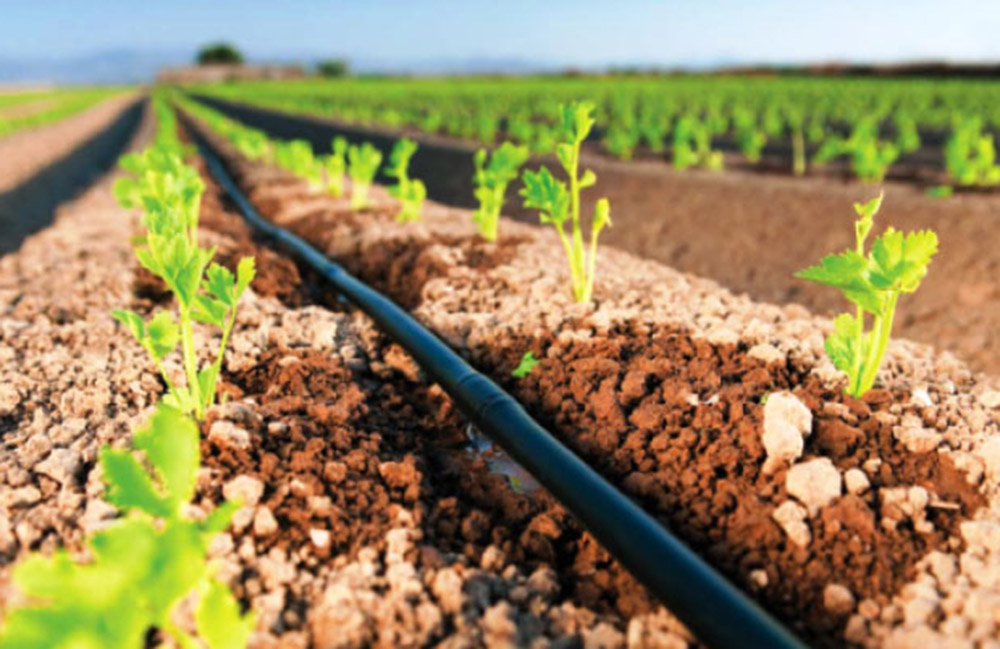
For more densely grouped plants you might choose to snake the dripline along the bed.

For plants in rows, dripline is run along the beds, kept in place by U-shaped hold-downs every 3 feet or so. Several different patterns are commonly used when laying out the tubing. This is then connected to quarter-inch dripline to supply the plants. The easiest way to do this is to punch a hole in the main tubing and insert a transfer barb which feeds thinner quarter-inch tubing up to where the water is needed. Once the supply tubing is in, it’s time to add the drip line. T-junctions can be used for line that comes off the main supply and each length needs to be finished with an End. To prevent this, it’s usual to cut the tube and insert a 90 degree elbow at each corner you have to go round. It’s important to identify any sharp bends as this could restrict water flow if the tube kinks. To pipe water to where it’s needed, half-inch supply tubing is ideal as it’s easily fixed to walls, cable-tied to other pipes or buried under pathways to avoid tripping over it. A pressure regulator which will prevent the water pressure exceeding what the drip pipes can handle – usually around 30 PSI for a small garden.

A filter to ensure that nothing passes through that can clog up the drip irrigation holes.Typically, this will be 10 to 15 minutes in the morning and/or evening. A timer which controls when the watering should happen.Most drip irrigation systems start with three things at the water source:

The most efficient way to irrigate crops is with “drip irritation” in which you automate the watering using a timer and delive water exactly where it’s needed. Combine this with guttering and water barrels and you can end up with an eco-friendly solution that stores excess water during wet weather that you can use efficiently during dry periods. Screw the cap on the top and water will slowly percolate out into the surrounding soil, providing a consistent water source. If you suffer from slug damage in your garden, it’s best to only apply mulch during summer as during damp seasons slugs can multiply under the protection of soft mulches.įor big plants such as tomatoes, burying a plastic bottle with a few small holes punched in the bottom can provide an extra water reservoir. Water can seep through this layer but it doesn’t evaporate quickly and the soil below is kept moist. To reduce evaporation, add a dry mulch on top of the soil such as a thin layer of dried grass clippings, comfrey leaves, hay, straw or wood chip. For crops that put down deep roots, watering more heavily but less regularly can help build up reserves of moisture deeper in the soil, making them more resistant to hot dry spells of weather. This is great for small seedlings but once the plants become larger it can mean that only the top inch of the soil is ever dampened. So, good irrigation is a high priority in gardens – as important as strong sunlight for most crops! DIY Drip IrrigationĪ lot of gardeners water little and often. Water not only hydrates plants (as it does humans) but it’s also the way nutrients are drawn up from the soil through roots and stems into leaves and fruit.

Plus, the water is at the root level so there’s no wetting of leaves from sprinklers constant water on cultivated vegetable leaves invites disease and is also very wasteful since water quickly evaporates, never reaching the roots.Īlso, there’s the convenience factor! When you are on vacation or simply away from your garden, drip irrigation can be set up with a timer to deliver water consistently. It’s a very efficient way to use water because the water goes straight to the plants without evaporation or runoff. Drip irrigation is the slow, even application of low pressure water to soil and plants using plastic tubing placed directly at the plants root zone.


 0 kommentar(er)
0 kommentar(er)
